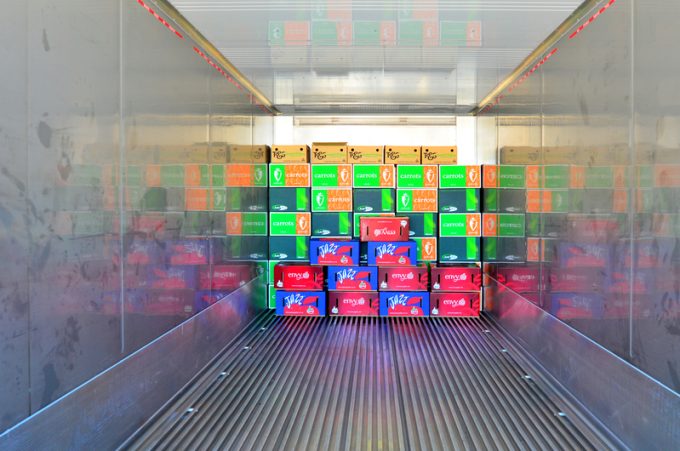Mayerline Santamaria Neira named Leschaco Colombia's new MD
German air and sea freight forwarder Leschaco has appointed Mayerline Santamaria Neira (above) as the ...
TFII: SOLID AS USUALMAERSK: WEAKENINGF: FALLING OFF A CLIFFAAPL: 'BOTTLENECK IN MAINLAND CHINA'AAPL: CHINA TRENDSDHL: GROWTH CAPEXR: ANOTHER SOLID DELIVERYMFT: HERE COMES THE FALLDSV: LOOK AT SCHENKER PERFORMANCEUPS: A WAVE OF DOWNGRADES DSV: BARGAIN BINKNX: EARNINGS OUTODFL: RISING AND FALLING AND THEN RISING
TFII: SOLID AS USUALMAERSK: WEAKENINGF: FALLING OFF A CLIFFAAPL: 'BOTTLENECK IN MAINLAND CHINA'AAPL: CHINA TRENDSDHL: GROWTH CAPEXR: ANOTHER SOLID DELIVERYMFT: HERE COMES THE FALLDSV: LOOK AT SCHENKER PERFORMANCEUPS: A WAVE OF DOWNGRADES DSV: BARGAIN BINKNX: EARNINGS OUTODFL: RISING AND FALLING AND THEN RISING

The rise and rise of reefer freight rates means fewer choices on supermarket shelves as some perishable products are priced out of the market.
Furthermore, a lack of available containers is creating “tough times” for many reefer shippers and their import partners, according to a reefer market update by DHL Global Forwarding.
It said: “A lot of places in the world at the moment lack reefer equipment. Additionally, dry container rates keep increasing to levels above reefer containers. As a result, shipping lines allocate space rather to dry instead of reefers.
“Therefore, reefer equipment is sometimes stuck for more than six months in Asia, even though there is more than enough reefer cargo to ship.”
Indeed, dry freight rates have proved so irresistible to carriers, that some have even opted to use unplugged reefers to carry dry cargo, putting further pressure on the deficit of equipment.
“Now, rates also keep increasing for reefers, more than 50% in Q3-Q4, year on year,” DHL explained. “How can Chinese ginger be sold in Europe if transport costs are the same as the product’s selling price? It’s a bizarre situation.
“We will see this continuing in 2022 and, potentially ,in 2023, with fewer products in supermarkets and mainly only larger shippers with strong financial backgrounds able to ship.”
Furthermore, elevated reefer container rates have led to particularly high demand for conventional reefer vessels, according to Rafael Llerena, CEO of 3PL EasyFresh.
He told The Loadstar: “The charter market is booming, it’s absolutely amazing. I cannot remember a January like this one, with charter rates peaking.”
Mr Llerena added that the market conditions were placing entire fruit sectors at risk, such as the melon trade from Central America.
“They are are suffering from the tremendous rise in supply chain costs, with importers in the US and Europe now seeking to source melons from elsewhere, mostly Africa,” he explained.
On the other hand, Mr Llerena said, the Chilean seedless grape market was stronger, but this was being overshadowed by higher input costs which include packaging and fertilisers which are “suffering the usual bottlenecks in shipping, as most of these products are shipped from China”, he explained.
“Moreover, the erratic schedules are impacting the shipping programmes fixed by the receiving end food retailers. Nevertheless, in this case, the higher produce quality [of Chilean grapes] is able to absorb a good part of the cost, compared with some other produce which is at risk,” said Mr Llerena.
Comment on this article
Martyn Benson
January 20, 2022 at 2:32 pmUnplugged reefers? Is this the new MTV album and video release?
I have always called them NORs – non-operating reefers.
How can Chinese ginger be sold in Europe? Airfreight it.
Conventional reefer rates peaking in January? Who would have guessed? They ALWAYS peak in January through to Easter.
Steve Alaerts
January 21, 2022 at 6:10 amThe MTV remark is very funny, Martin. It tells something about our age – of course, non-operating reefer boxes is the term used.
Steve Alaerts
January 21, 2022 at 6:22 amWe don’t see dramatic situations on our supermarket shelves yet, although some categories may suffer harder than others in the next coming months. The fresh produce export from Europe still goes strong. So, in dire need of more ‘operating’ reefer box availability. The positioning of non-operating reefer boxes helps, but our industry prefers healthy balanced trade with fresh imports, such as the Indian grape season that started shipping this week with some delay.